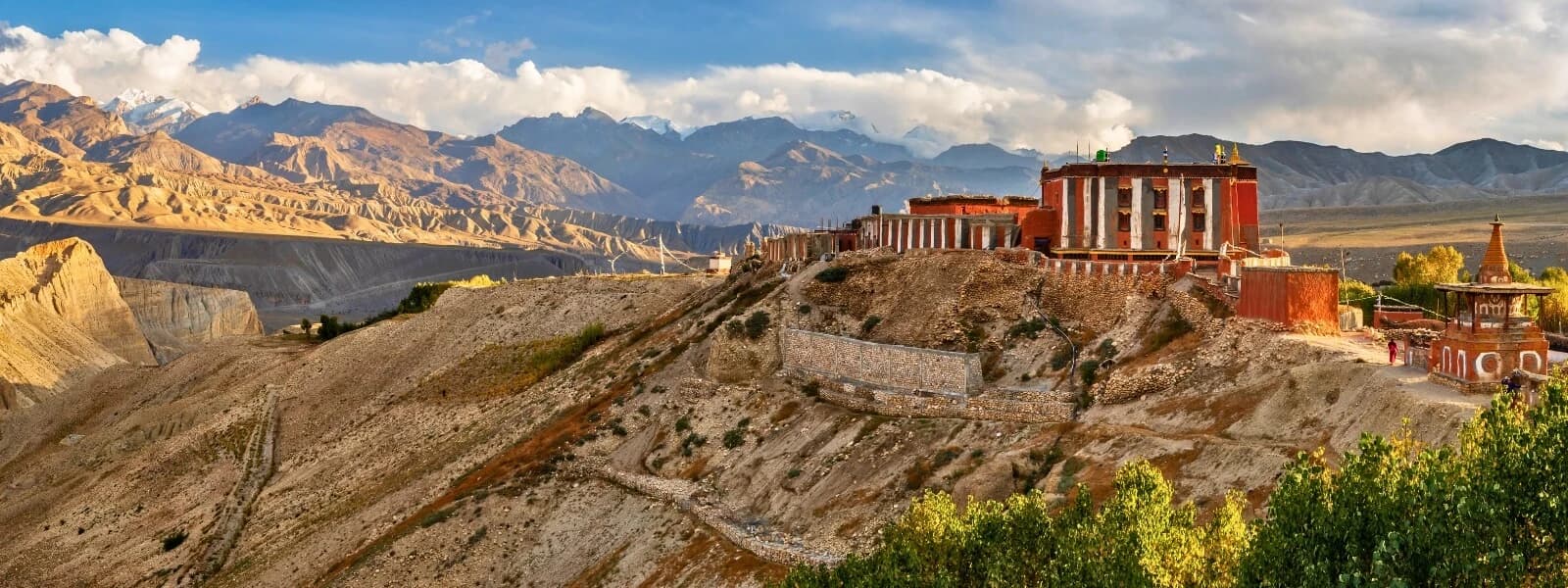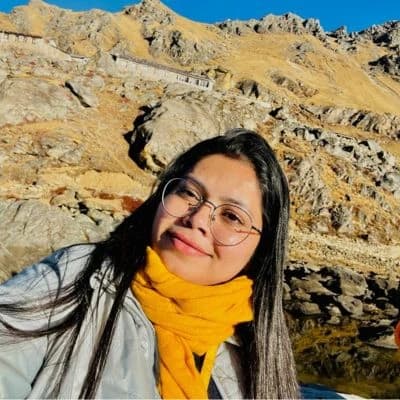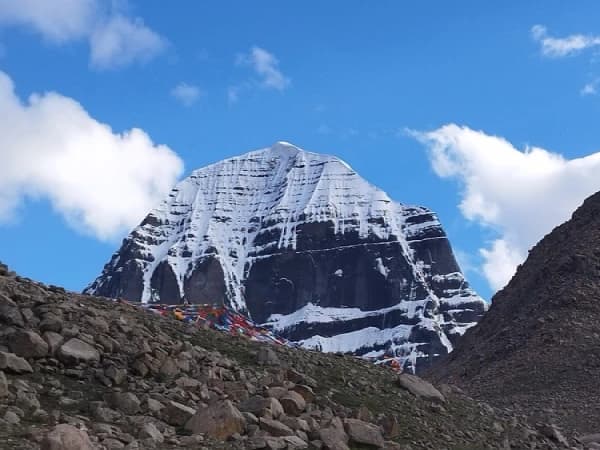The Upper Mustang Trek enters you to the tanned red cliffs and the endless variations of grey rolling hills. This trek is all about exploring the hidden ancient histories of the Buddhist Kingdom of Mustang. Upper Mustang was a restricted area until 1991 A.D. Since it has not been opened for long, the area is raw and not much explored. So you have a lot to explore in Upper Mustang.
Guide to Upper Mustang Trek in Spring Season
Upper Mustang Trek Guide in Spring Season
Upper Mustang Trek began to gain popularity among trekkers due to the adventures and experience of cool and semi-arid clime. Along with that Upper Mustang is rich in ancient arts and ancient mythologies.
The Upper Mustang Trek enters you to the tanned red cliffs and the endless variations of grey rolling hills. This trek is all about exploring the hidden ancient histories of the Buddhist Kingdom of Mustang. Upper Mustang was a restricted area until 1991 A.D. Since it has not been opened for long, the area is raw and not much explored. So you have a lot to explore in Upper Mustang.

Being in the rain shadows of the Dhaulagiri and Annapurna ranges, Upper Mustang has unfertile soil which is why you won’t see any greenery here. This is the reason why you can also trek in this area during the rainy season as well. Upper Mustang used to be the ancient trade route between Tibet and Nepal passing Kora La and passing through the western Himalayas of Sikkim. Since Mustang was a part of the Tibetan plateau before the 18th century, many people here still have inherited the culture of Tibet.
Upper Mustang Trek is a rated moderate level of difficulty. Trekking in Upper Mustang provides you an opportunity to embrace the natural and cultural beauty of mountain areas. Most of the accommodations during the trek are in tea houses. The Upper Mustang Trek directs you towards the trans-Himalayan region lying on the Northern border of Nepal with Tibet. Tiji festival, Lo-Manthang, Muktinath, etc are a few major attractions of this trek.
Highlights of Trip:
Here are a few highlights of Upper Mustang Trek:
- Splendid views of Dhaulagiri, Annapurna, Nilgiri, and many more mountain ranges.
- Exploring the hidden caves and history of the Mustang.
- Getting to know both Buddhist and Tibetan cultures.
- Closer view of the lifestyle of locals influenced by Tibetan culture.
- Favorable area for the trek in the Rainy season as well.
- Beautiful landscapes.
Trip overview:
Starting Point: Kathmandu
Ending Point: Kathmandu
Total Number of Days: 14 to 16
Trek Difficulty: Moderate
Average trek per day: 4 to 7 hours
Maximum Altitude: 4030m
Accommodations and Meals during Upper Mustang Trek in Spring
Although Upper Mustang was an isolated part of Nepal, it has gained lots of popularity these days. This is the reason why you will find tea houses and lodges at every point of your trail.
The lodges and tea houses provide you rooms with two beds and also have halls for huge groups. They provide you with fluffy pillows and warm blankets. They have western-style toilets and will give you hot showers. You will find the price of accommodations in this region a bit expensive due to expensive transportation, and isolation.
For meals, they have regular local Nepali cuisine (Dal, Bhat, and Tarkari). For breakfast you can get bread, jams, butter, boiled eggs, cornflakes, toasts, etc. they also provide you with tea, coffees, juice, etc. They also have momos, pasta, pizzas, noodles, canned foods, etc most of the time.
Route to Upper Mustang Trek
The Upper Mustang Trek begins with a scenic drive from Kathmandu to Pokhara (830m) that will take around 7 hours. After reaching Pokhara, you can relax in a hotel or sightsee the lakeside areas. The next day begins with a short flight to Jomsom flying above beautiful mountains. After landing in Jomsom, the trek begins and heads the trail towards Kagbeni (930m). You will spend the night in Kagbeni and can hike to the Kali Gandaki hill for a great view.
Leaving Kagbeni the trail continues to Chele (3050m) for 5 to 6 hours. The trail passes along the Kali Gandaki River and following the ridge takes you to Chele village. The next day you will have breakfast and hike to Syangmoche. The 6 hours hike becomes a bit difficult as you cross the Taklam La Pass (3624m) and Dorja La Pass (3735m). Passing through this point gives you a majestic view of mountains and landscapes. Then you will reach Syangmoche (3475m). The trail then heads to Ghami which is 5 hours away from Syangmoche.
The trail again passes through a big pass – the Yamada La (3850m). Walking along the jungle and passing the Nyi Pass (4010m) will take you to Ghami village (3500m). The next day you have 4 hours of trek to Charang (3560m), the route here is quite rough and slippery at some point. You will see mani walls throughout the trek and also pass through Charang La Pass. You can visit the red gompa in Charang.
Leaving Chrang village, the trek directs you towards Lo Manthang (3770m). You will cross the river and ascend to the Lo La Pass (3950m). From here you can view the beautiful Lo Manthang village. This village is rich in culture and history as well as offers the best mountain views. The next day is the day to explore the Upper Mustang and trip to Chooser Cave. Trek of 6 hours takes you to Chhoser Cave. You can explore many caves in this area, a researcher from many years still has no idea who built the high caves into the side of cliffs. After exploring and enjoying the day, you will return to Lo Manthang for the night.
The next day you will head to Dhakmar (3800m) which is 7 hours away. On the way, you will visit the Gyakar village which is home to century-old Gompa with rock paintings. Then you will reach Dhamkar. After Dhamkar the next destination is Ghiling (3860m), from here you will have a great view of Nilgiri and Dhaulagiri. The next day descends to Chuksang trekking for 6 hours. Overnight stay in Chuksang. The next morning the trail descends to Jomsom following the same old path. From Jomsom, it is a 15 minutes flight back to Pokhara. You can spend a day in Pokhara and then return back to Kathmandu by flight or bus.
Best Time for Upper Mustang Trek
Trekking in the best season will make your journey comfortable and more improvised. Following is the time you can consider for the Upper Mustang Trek:
Spring is the best time of the year to trek in the Upper Mustang. Usually, spring starts in March and ends in May in Nepal. Along with clear weather, you will be able to attend the Tiji festival which is celebrated for 3 days in the month of May. During these months you can also get a great view of landscapes and mountain views. Sine Upper Mustang lies in the rain shadows of the Dhaulagiri and Annapurna ranges, this area is favorable in rainy seasons too.
Autumn (September to November) is another best season for Upper Mustang Trek. The temperature during this time is cool and gives you the majestic vegetation of the Himalayan arid plateau.
Permits required during Upper Mustang Trek
Upper Mustang is considered one of the restricted places in Nepal which are near the Tibet border. So here are the permits you need to have to complete the Upper Mustang Trek:
Entry permits in this region cost $500 per person for 10 days and $50 per day for additional days.
Restricted Area Permit (RAP) costs $500 per person for 10 days and an additional $50 per day for additional days. This permit is required when you leave Kagbeni.
Along with the above 2 permits the trekkers need to pay $20 for the ACAP (Annapurna Conservation Area Permit).
How difficult is Upper Mustang Trek?
Upper Mustang Trek is rated moderate in difficulty. This trek is not easy but not so challenging as well. The trek can be difficult while passing through various high altitudes passes like Nyi Pass (4010m), Taklam La Pass (3624m), Dorja La Pass (3735m), and Lo La Pass (3950m), etc. passing though points may give you altitude sickness. For this, you should drink plenty of water.
Another difficulty in this is dust, this region has less rainfall and the roads are rocky and full of soil. So the trekking routes are full of dust. The landscapes and roads in Upper Mustang are full of ups and downs so that might be a bit difficult for you. Along with that, you must know that the region is isolated so accommodations are not as good as you trek upwards.
Trekking gears useful for Upper Mustang Trek
Here are a few essential gears you should carry for the Upper Mustang Trek:
- Warm clothes, Windproof jackets, Waterproof pants and jackets, shades, masks, scarves, gloves, caps, etc.
- Toiletries, wet tissues, hand sanitizer, etc.
- Portable Charger, trekking sticks, sleeping bags, light-weighted trekking shoes, etc.
FAQs
Why Upper Mustang is a restricted area?
Upper Mustang was a restricted area until 1992. Due to this the regions have been preserved from the outside world and isolated with few populations using Tibetan tradition and language. Slowly the region is opening to tourists.
What is Upper Mustang famous for?
Upper Mustang is famous for its spectacular landscapes and mountain views along with great unexplored histories.
Are the accommodations well facilitated?
The main accommodation on this trek is a tea house. The facilities decrease as you trek in the upper region.
Is there internet service in the Upper Mustang trek?
There is no internet service in the Upper Mustang trek after you cross Jomsom. For calls, Namaste sim cards seem to work.






